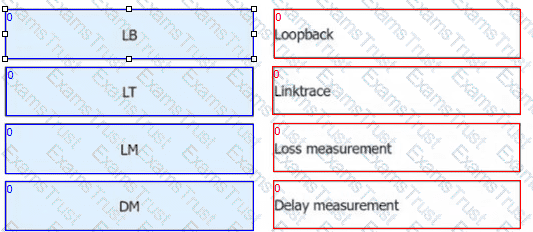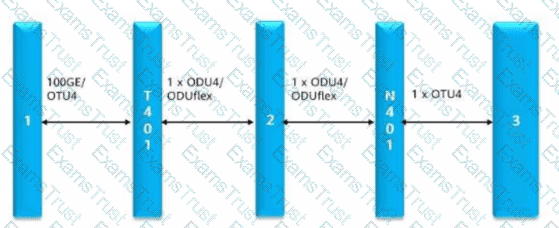The OTUk_LOM alarm is generated when the out of multiframe (OOM) state lasts for 3 ms.
OTUk_DEG indicates OTUk signal degradation. Which of the following statements about the bit error detection mode are true? (Choose all that apply.)
An RDU9 board can dynamically demultiplex any wavelength to any port.
In an OA system, the lower threshold of the receive optical power of a line board (with an APD receiver laser) or the WDM side of an OTU board is the optical module's receiver sensitivity plus 5 dB.
If the mask of an IP subnet is 27 bits, how many hosts does the subnet have?
Which of the following statements about QPSK modulation are false?
OTUCn and ODUCn implement the functions of the digital section and channel layer.
FILL BLANK
ODUk SNCP has three subtypes: _____, ______, and _____. (Enter the acronyms in uppercase letters.)
To prevent the optical power at the receive end of an OTU board from being excessively high, you must configure a fixed attenuator according to the actual optical power. The fixed attenuator is usually configured at the transmit end.
During CV/FFD, the ingress node transmits detection packets at a specific interval, and the egress node checks the number and content of these packets at an interval ( ) times the length of the detection packet transmission interval.
When a member port is added to or deleted from a static LAG, LACP must be started.
Which of the following statements about OTN frame structure overheads is false?
When the R_LOS, R_LOF, R_OOF, or MUT_LOS alarm is reported on a device, services are interrupted.
The EDFA amplifies service signals and brings noise to the system. It is the main source of noise.
A multiframe alignment signal is used for multiframe alignment. When some OTUk and ODUk overhead signals need to be transmitted across multiple frames, the MFAS must be used to implement multi-frame alignment.
When the TTI to be received at the PM layer is inconsistent with the TTI actually received at the PM layer, which of the following alarms will not be reported?
Which of the following is not an advantage of WDM?
OTUk_LOM is an alarm indicating that the frame alignment signal (FAS) is abnormal. This alarm occurs when the frame alignment processing is out of frame (OOF) for three consecutive milliseconds.
Which of the following is not a trigger condition for the automatic switching of client 1 +1 protection?
When a GE service is encapsulated into an OTN frame structure and an SDH frame structure, the alarms reported by client-side devices are different.
The receiver of an OTU board is an avalanche photodiode (APD). Which of the following is within the input optical power range?
In a scenario where non-convergence OTU boards process standard SDH signals, both site A and site B are WDM sites, and the R_LOS alarm is detected on the client side of the OTU board at site A. After an alarm is processed on the WDM side of the OTU board, the REM_5F alarm is reported on the client side of the downstream site B. Then, site B transmits the signals to its downstream client device and reports the R^LOS alarm to the client device.
For hybrid transmission of 100G-and-beyond and 10G signals, it is recommended that the optical power of 100G and beyond signals be higher than that of 10G signals but not higher than the single-wavelength nominal value of an OA board.
In a 1+1 OTS optical line protection scenario, when the network is normal, the input optical power of the RI1 port on the OLP board is 10 dBm and that of the RI2 port on the OLP board is 8 dBm. The initial input difference between the working and protection channels is set to the default value 0dB, and the input difference threshold of the working and protection channels is set to default value 5dB. Which of the following scenarios can trigger switching?
Which of the following statements about OUT boards are true? (Choose all that apply.)
Which of the following statements about the TMB1AST2 board are true?
Select the correct on-demand OAM type based on the description for the blank area.

Which of the following statements about a TNG2WSMD09 board aretrue? (Choose all that apply.)
The difference threshold between the working and protection channels in 5 dB. The initial optical power on both channels is 2 dBm. When the fiber attenuation of the working channel increases, its optical power changes to -4 dBm and the optical power of the protection channel remains unchanged. This triggers optical line protection switching.
In an OA-free system, the lower threshold of the receive optical power of a line board or the WDM side of an OTU board Is the optical module's receiver sensitivity plus 3 dB.
The single wavelength incident optical power of a 100G system is lower than that of a 10G system. When 100G channels are expanded In a 10G system, the OA gain can be reduced to decrease the single-wavelength output optical power of the OA to meet the incident optical power requirements.
Drag the correct answer to the corresponding number in the picture.


When LCK is inserted at the local ODUk PM overhead, how does the downstream site process the insertion?
The OTUk frame rate can be concluded based on OTU1, OTU2, and OTU3 frame rates. Which of the following is the correct formula for calculating the OTUk frame rate?
Lower ground resistance indicates better grounding, that is, faster conduction of current to the ground.
Which of the following statements about optical multiplexer and demultiplexer boards is false?